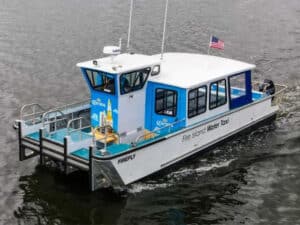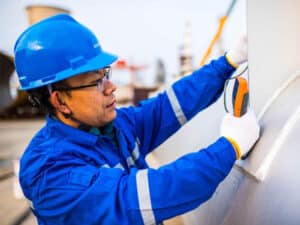
MHI completes full scale two-stroke engine test facility
Written by JULY 9, 2012 – A ceremony has been held at the Kobe Shipyard and Machinery Works of Japan’s Mitsubishi Heavy Industries, Ltd. (MHI) to mark completion of 4UE-X3, a testing facility for full-scale low-speed, two-stroke marine diesel engines.
JULY 9, 2012 – A ceremony has been held at the Kobe Shipyard and Machinery Works of Japan’s Mitsubishi Heavy Industries, Ltd. (MHI) to mark completion of 4UE-X3, a testing facility for full-scale low-speed, two-stroke marine diesel engines.
The facility will be used for testing of various technologies to respond to stringent environmental regulations expected to be applied to the shipping industry in the future. It will also be used for verification testing of UEC-LSGi, a dual-fuel low-speed marine diesel that is capable of using natural gas for its fuel, which the company has recently been developing (see earlier story).
The 600 mm bore x 2,400 mm stroke, four-cylinder 4UE-X3 testing machine has been developed based on the Mitsubishi UEC60LSE-Eco low-speed marine diesel engine. Initially, the 4UE-X3 will have a bmep of 21.0 bar and an output of 9,970 kW at 105 rpm.
The testing machine will be used for verification of various technologies to comply with IMO Tier III NOx (nitrogen oxide) emission regulations that will apply to the engine of ships to be newly built after 2016, requiring the reduction of NOx emission by 80 percent.
MHI has already achieved a de-NOx rate of 80 percent on-board test using an actual ship with the company’s SCR (selective catalytic reduction) technology and is looking to commercialize that system. The 4UE-X3 will be used for a technology verification of MHI’s EGR (exhaust gas recirculation) system, using actual size components. It will also be used to verify waste heat recovery technology, including ORC (Organic Rankine Cycle) technology, a waste heat recovery system using an organic refrigerant with a low boiling point also used in residential-use air-conditioners.
Adjoining the testing facility, a training facility and practicing room have been set up, where disassembly and maintenance of the diesel engine’s major components can be carried out. The facilities will also be used to provide operation and maintenance training to customers.




![L to R: Patrick Ryan, ABS Senior vice president and chief technology officer, and Keyyong Hong, president of KRISO.[photo: ABS]](https://www.marinelog.com/wp-content/uploads/2025/10/abskrisco-300x225.jpg)
Leave a Reply
You must be logged in to post a comment.